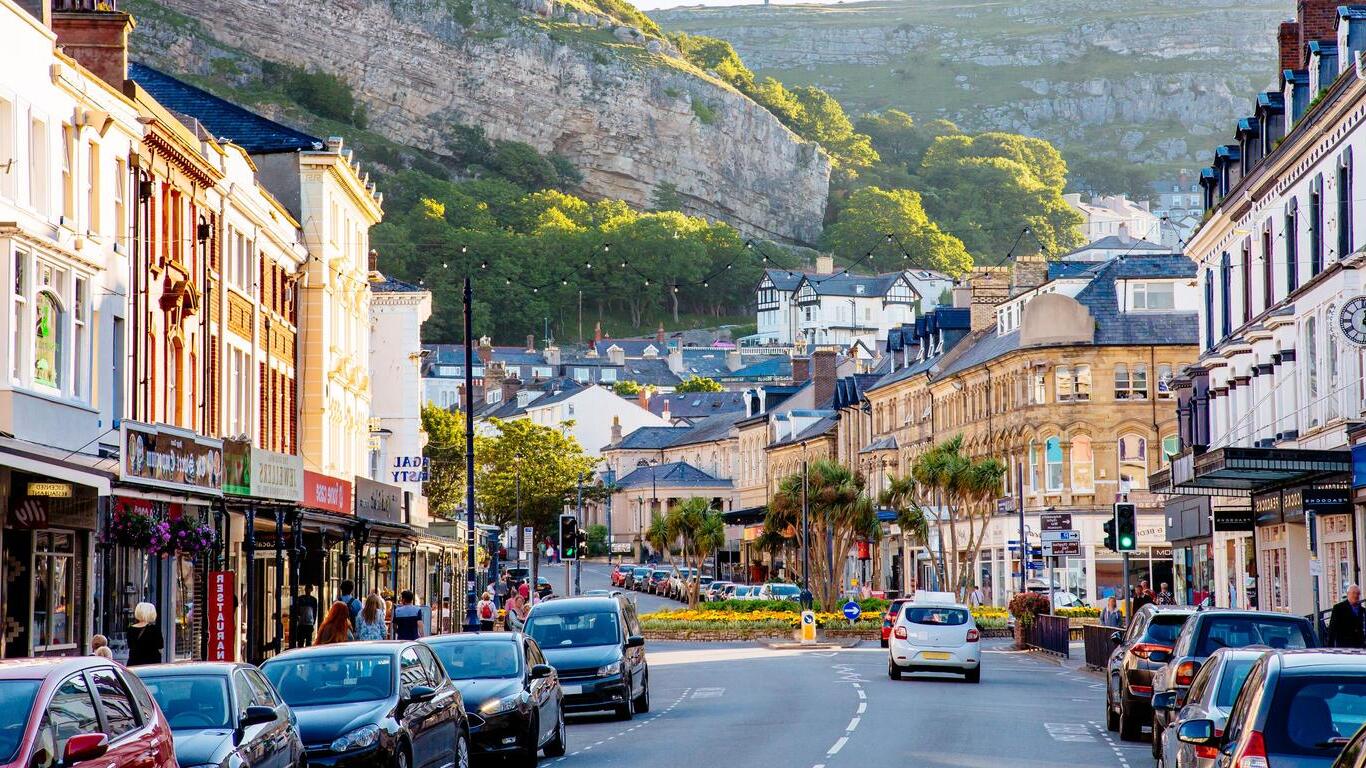
Why is Llandudno known as the "Queen of Welsh Resorts"? This charming seaside town in North Wales boasts a rich history, stunning Victorian architecture, and a plethora of unique attractions. From its ancient origins dating back to the Stone Age to its transformation into a bustling holiday destination, Llandudno has captivated visitors for centuries. The town's development was significantly influenced by Lord Mostyn's vision and the arrival of the railway in 1848. Today, Llandudno offers a blend of natural beauty, cultural events, and historic landmarks, making it a must-visit destination. Whether you're exploring the Great Orme, enjoying a Punch and Judy show, or following the Alice in Wonderland trail, Llandudno promises an unforgettable experience.
Key Takeaways:
- Llandudno's rich history dates back to ancient times, from Stone Age settlements to Victorian architecture, shaping it into a vibrant holiday resort with cultural events and literary connections.
- The town's unique attractions, from the Great Orme cable cars to the Alice in Wonderland Trail, showcase its historical significance and community spirit, making it a must-visit destination.
Ancient Origins and Name
Llandudno, a town with a rich history, has roots that stretch back to ancient times. Its name and early settlements tell a story of a place that has evolved over millennia.
- Llandudno's history dates back to the Stone Age, Bronze Age, and Iron Age, with ancient settlements on the slopes of the Great Orme and Creuddyn Peninsula.
- The town's name, Llandudno, translates to "the enclosure of St. Tudno," derived from the patron saint of the local church.
From Mining Settlement to Holiday Resort
Llandudno's transformation from a small mining settlement to a bustling holiday resort is a tale of vision and development.
- Originally, Llandudno was a small mining settlement with a population of less than 1,000 people by 1847. Most men worked in copper mines, while others fished or farmed.
- In 1848, Owen Williams, an architect and surveyor from Liverpool, presented Lord Mostyn with plans to develop the marshlands behind Llandudno Bay as a holiday resort. This vision was enthusiastically pursued by Lord Mostyn, leading to significant development in the area.
- The influence of the Mostyn Estate and its agents, particularly George Felton, was paramount in the development of Llandudno. Felton designed and executed many of the town's central buildings, including Holy Trinity Church in Mostyn Street.
Victorian Architecture and Railway Connection
The Victorian era left a lasting mark on Llandudno, with its architecture and railway connection playing crucial roles in the town's growth.
- Llandudno is just off the North Wales Coast railway line, which was opened as the Chester and Holyhead Railway in 1848. This railway connection played a crucial role in the town's growth as a tourist destination.
- Many of the original buildings in Llandudno were erected during the winter months to avoid disturbing summer visitors. During the summer, skilled Welsh builders would travel to America to continue their work, influencing the architecture of towns like Bala, Caernarfon, Swansea, and Newport.
Cultural Events and Literary Connections
Llandudno has a rich cultural heritage, hosting significant events and inspiring literary works.
- Llandudno has hosted several significant cultural events, including the Welsh National Eisteddfod in 1864, 1896, and 1963, and the Urdd National Eisteddfod in 2008.
- Matthew Arnold's vivid descriptions of 1860s Llandudno in his work "On the Study of Celtic Literature" highlight the town's rich cultural heritage. Llandudno also inspired Lewis Carroll, who wrote parts of "Alice in Wonderland" during a stay there.
Famous Residents and Wildlife Attractions
The town has been home to notable figures and unique wildlife, adding to its charm and appeal.
- Llandudno has been home to several notable figures, including Australian Prime Minister Billy Hughes, who attended school in the town. Other famous residents include multi-capped Welsh international footballers like Neville Southall and Joey Jones.
- The Great Orme is home to several large herds of wild Kashmiri goats, originally descended from a pair presented by the Shah of Persia to Queen Victoria. These goats have become a popular attraction in the town.
Unique Attractions and Historic Events
Llandudno offers unique attractions and has a history marked by interesting events.
- The cable cars on the Great Orme are the longest in the UK, built in 1969 to take visitors from Happy Valley to the top of the Great Orme. These cable cars offer breathtaking views of the surrounding landscape.
- Llandudno boasts one of the oldest Punch and Judy shows, running at the entrance to the pier for over 150 years. Daily shows take place in the summer, weather permitting.
- A quarter of a mile west of the Great Orme lighthouse lies the Hornby Cave, named after the 280-ton Liverpool brig Hornby. The vessel was wrecked on New Year’s Day night in 1824, resulting in the only survivor, John Williams, jumping onto a rock and later telling his story to local copper miners.
- There have been two lightning fatalities in Llandudno. In 1861, a local carriage driver named Thomas Jones was struck dead by lightning during a thunderstorm. Another fatality occurred when a carriage proprietor named John Davies was taking visitors on Marine Drive and was struck by lightning.
Cave Dwellers and Historic Concert Hall
Llandudno's history includes unique stories of cave dwellers and historic entertainment venues.
- The Jones family, consisting of Miriam and Isaac from Amlwch, lived in a natural cave on Llandudno’s West Shore for 37 years. They raised 15 children, including three sets of twins, before facing eviction in 1877 to make way for Marine Drive. The family refused to leave until they were given a new home by the construction company.
- Miriam, known as Miriam yr Ogof (Miriam of the cave), continued to provide refreshments for passing visitors from her new home on Marine Drive. She died aged 91 and was remembered for her hospitality. Her great-grandson Ted Jones, also known as Ted Rogo, was one of the last people to fish and offer trips to the lighthouse in the 1950s and 1960s.
- The Mountain Warehouse store site was once the location of Llandudno’s first permanent place of entertainment, St. George’s concert hall. The first two shows held there were operas by Mozart.
Piers and Art Gallery
Llandudno's piers and art gallery are significant landmarks that reflect its historical and cultural development.
- Llandudno has had three piers. The first pier, built in 1858, lasted only 19 years before being demolished. The second pier, located on the North Shore, is the one currently in use. The third pier on the West Shore had a short life and was swept away by the sea.
- The Oriel Mostyn art gallery, located in Vaughan Street next to the post office, was built in 1901 to house Lady Augusta Mostyn’s art collection. It was requisitioned during World War I and later became a warehouse before being restored as an art gallery in 1979. The gallery was renamed simply 'Mostyn' in 2010 after a major revamp.
Festivals and Historic Motto
Llandudno's festivals and historic motto highlight its vibrant cultural scene and community spirit.
- Llandudno hosts its own mini arts festival, showcasing local talent and creativity. The festival is a testament to the town’s vibrant cultural scene.
- Llandudno’s official motto, "hardd, hafan, hedd," translates to "beautiful, haven, peace." This motto was inspired by Elisabeth of Wied, the Queen Consort of Romania, who described Wales as a "beautiful haven of peace" during her five-week stay in 1890.
Historic Buildings and Mining Heritage
The town's historic buildings and unique mining heritage add to its rich historical tapestry.
- Two of the original houses in Llandudno, "The Ship" and Ty Gwyrdd (Green House), are still standing today. These houses are located opposite St. George’s Church and are excellent examples of the town’s early architecture.
- The miners in Llandudno were known for their unique way of claiming freehold property. If a miner could build a cottage, move his family in, light a fire, and eat a meal in it all within one night, he could claim the land as his own. This practice led to many miners owning their own homes and plots of land.
Harbour Plans and Railway
Before becoming a popular health resort, Llandudno had plans for a harbour and a significant railway connection.
- Before becoming a popular health resort, there were plans to turn Llandudno Bay into a "harbour of refuge." The harbour was to be called St. George’s Harbour, and the railway between Llandudno and Llandudno Junction was initially referred to as the St. George’s Harbour Railway.
- The railway between Llandudno and Llandudno Junction was originally part of the St. George’s Harbour Railway plan but was later renamed. Today, it remains an important transportation link for the town.
Great Orme and Alice in Wonderland Trail
The Great Orme and the Alice in Wonderland Trail are unique attractions that draw visitors to Llandudno.
- Most of the Great Orme is owned by Mostyn Estates. The area is home to several large herds of wild Kashmiri goats, which have become a popular attraction in the town.
- Llandudno has an "Alice Trail" that takes visitors around the town to see various statues and other attractions related to Lewis Carroll’s classic book. This trail is a must-visit for fans of the novel.
Historic Homes and Cultural Significance
Llandudno's historic homes and cultural significance are reflected in its notable residents and literary connections.
- Bryn Rosa, on Abbey Road, was the childhood home of Australian Prime Minister Billy Hughes. He emigrated to Australia in 1884 and went on to become a prominent figure in Australian politics.
- Llandudno has been the setting for several literary and dramatic works. The town is mentioned in Matthew Arnold’s "On the Study of Celtic Literature" and was used as a location for scenes in the stage play and film "Hindle Wakes" by Stanley Houghton, as well as Arnold Bennett’s novel "The Card" and its film adaptation.
Tourist Attractions and Community Events
Llandudno offers a variety of tourist attractions and hosts numerous community events throughout the year.
- Llandudno is known for its stunning scenery and Victorian architecture. The town offers a variety of tourist attractions, including the Great Orme cable cars, Punch and Judy shows, and historic buildings like St. George’s Church.
- The town hosts various community events throughout the year, including the Urdd National Eisteddfod and the Liverpool Olympic Festival. These events showcase the town’s rich cultural heritage and community spirit.
Historic Landmarks and Wildlife Conservation
Llandudno's historic landmarks and wildlife conservation efforts are integral to its identity.
- Llandudno has several historic landmarks, including the Oriel Mostyn art gallery, St. George’s Church, and the Great Orme cable cars. These landmarks are a testament to the town’s rich history and architectural significance.
- The Kashmiri goats on the Great Orme are an important part of the town’s wildlife conservation efforts. These goats have become an iconic symbol of Llandudno and attract tourists from around the world.
Educational Institutions and Historic Homes
Llandudno's educational institutions and historic homes reflect its commitment to preserving its heritage.
- Gordon Borrie QC (Baron Borrie), Director General of the Office of Fair Trading from 1976 to 1992, was educated at John Bright Grammar School in Llandudno. The school has a long history of providing quality education to its students.
- The Jones family lived in a natural cave on Llandudno’s West Shore for 37 years. The cave is now the garage of a house called St Petrock’s, and a memorial to Ted Jones, who fished and offered trips to the lighthouse, can be found on the Promenade.
Historic Concerts and Shipwreck Legacy
Llandudno's history includes notable concerts and a legacy of shipwrecks.
- St. George’s concert hall, located at the site of the Mountain Warehouse store, hosted its first two shows featuring operas by Mozart. This historic concert hall played a significant role in Llandudno’s cultural scene.
- The Hornby Cave, named after the wrecked brig Hornby, serves as a reminder of Llandudno’s maritime history. The wreck occurred in 1824 and resulted in significant loss of life and property.
Lightning Strikes and Community Spirit
Llandudno's history includes rare lightning strikes and a strong sense of community spirit.
- Llandudno has experienced two lightning fatalities. In 1861, Thomas Jones was struck dead by lightning during a thunderstorm. Another fatality occurred when John Davies was taking visitors on Marine Drive and was struck by lightning.
- Llandudno is known for its strong community spirit. The town hosts various community events and has a rich cultural heritage that is celebrated through its history, architecture, and natural beauty.
Llandudno: A Blend of History and Charm
Llandudno, often called the "Queen of Welsh Resorts," is a town rich in history and natural beauty. From its ancient origins to its Victorian architecture, this seaside gem offers a unique blend of past and present. The Great Orme with its wild Kashmiri goats, the historic piers, and the Alice in Wonderland Trail are just a few highlights that make Llandudno special. The town's cultural events, like the Welsh National Eisteddfod, showcase its vibrant community spirit. Notable figures, including Australian Prime Minister Billy Hughes, have called Llandudno home, adding to its storied past. Whether you're drawn by the stunning scenery, the historic landmarks, or the rich cultural heritage, Llandudno has something for everyone. This charming town continues to captivate visitors with its unique blend of history, culture, and natural beauty.
Frequently Asked Questions
Was this page helpful?
Our commitment to delivering trustworthy and engaging content is at the heart of what we do. Each fact on our site is contributed by real users like you, bringing a wealth of diverse insights and information. To ensure the highest standards of accuracy and reliability, our dedicated editors meticulously review each submission. This process guarantees that the facts we share are not only fascinating but also credible. Trust in our commitment to quality and authenticity as you explore and learn with us.


